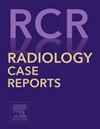肉芽肿合并多血管炎的MRI表现可与胆脂瘤相似
Q4 Medicine
引用次数: 0
摘要
中耳疾病是全科医生和耳鼻喉科医生都遇到的常见问题;症状包括疼痛、分泌物、发烧和听力丧失。常见的初步诊断包括急性和慢性中耳炎、胆脂瘤和坏死性中耳炎。肉芽肿病合并多血管炎是一种罕见的自身免疫性疾病,其特征是坏死性血管炎和肉芽肿性炎症,可影响上、下呼吸道、肾脏和其他器官的中小血管。此外,肉芽肿病合并多血管炎在中耳和颞骨的表现是非常出乎意料的。更严重的病例包括周围软组织感染,如耳道脓肿和颞骨受累,称为骨髓炎。在这种情况下,症状包括眩晕、面瘫和全身感染。在这里,我们报告一个17岁的女孩,她有左侧慢性中耳炎的病史,她对通常的治疗没有反应,表现为头晕和左侧周围面部麻痹。体格检查显示左侧传导性听力损失明显,左侧持续性周围性面瘫,伴IX-XI型脑神经麻痹。我们在磁共振成像的弥散加权成像序列中发现初始扩散限制,类似于胆脂瘤和中耳脓肿。早期诊断肉芽肿病合并多血管炎,可以及时进行免疫抑制治疗,从而防止晚期并发症的发生。因此,放射科医生必须意识到这些对常规治疗无反应的中耳炎患者的磁共振成像结果,无论是否伴有面瘫。通过这个病例报告,我们的目的是强调肉芽肿病合并多血管炎作为胆脂瘤的额外鉴别诊断。本文章由计算机程序翻译,如有差异,请以英文原文为准。
MRI findings of granulomatosis with polyangiitis can mimic those of cholesteatoma: A case report
Middle ear diseases are a common problem encountered by both general practitioners and otolaryngologists; the symptoms include pain, discharge, fever, and hearing loss. Common initial diagnoses include acute and chronic otitis media, cholesteatoma, and necrotizing otitis. Granulomatosis with polyangiitis is a rare autoimmune disease characterized by necrotizing vasculitis and granulomatous inflammation that affects the small- and medium-sized vessels of the upper and lower respiratory tracts, kidneys, and other organs. Furthermore, manifestations of granulomatosis with polyangiitis in the middle ear and temporal bone are highly unexpected. The more severe cases involve infection in the surrounding soft tissue, such as ear canal abscess and involvement of the temporal bone called osteomyelitis. In such cases the symptoms can involve vertigo, facial palsy, and systemic infection. Herein, we report a case of a 17-year-old girl with a history of left-sided chronic otitis media who was unresponsive to the usual treatment and presented with dizziness and left-sided peripheral facial paresis. Physical examination revealed a significant left-sided conductive hearing loss and left-sided persistent peripheral facial palsy, along with IX-XI cranial nerve palsies. We found initial diffusion restriction on diffusion-weighted imaging sequences of magnetic resonance imaging, which mimics cholesteatoma and middle ear abscess. Early diagnosis of granulomatosis with polyangiitis enables timely treatment with immunosuppressive therapy, thereby preventing the occurrence of late complications. Therefore, radiologists must be aware of these magnetic resonance imaging findings in patients with otitis media who are unresponsive to usual treatment, with or without facial palsy. Through this case report, we aim to highlight granulomatosis with polyangiitis as an additional differential diagnosis of cholesteatoma.
求助全文
通过发布文献求助,成功后即可免费获取论文全文。
去求助
来源期刊

Radiology Case Reports
Medicine-Radiology, Nuclear Medicine and Imaging
CiteScore
1.10
自引率
0.00%
发文量
1074
审稿时长
30 days
期刊介绍:
The content of this journal is exclusively case reports that feature diagnostic imaging. Categories in which case reports can be placed include the musculoskeletal system, spine, central nervous system, head and neck, cardiovascular, chest, gastrointestinal, genitourinary, multisystem, pediatric, emergency, women''s imaging, oncologic, normal variants, medical devices, foreign bodies, interventional radiology, nuclear medicine, molecular imaging, ultrasonography, imaging artifacts, forensic, anthropological, and medical-legal. Articles must be well-documented and include a review of the appropriate literature.
 求助内容:
求助内容: 应助结果提醒方式:
应助结果提醒方式:


